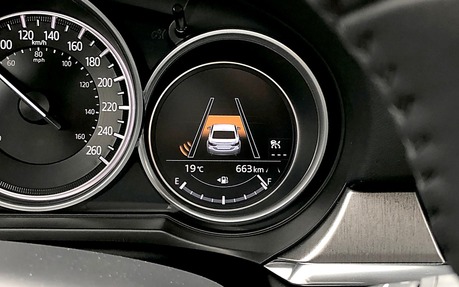When Mazda Cries Wolf, the Self-driving Car Suffers
Driving one of the newer Mazda cars and SUVs is to be pointlessly deafened by its Blind Spot Monitoring system. What gives?
In terms of automotive technology, we can say that Mazda is going at it alone. The modest Japanese car manufacturer hasn’t resisted the turbocharging trend, does not really believe in electric mobility (although this might change), and seemingly does not want to be among the firsts to market a self-driving vehicle.
When your slogan has been “Zoom-Zoom” for over a generation, it means you probably prefer to see real human drivers steering your vehicles. The rest of the car industry does not see things that way, however.
Even Mazda sees benefits in those newish driving assist systems. Its cars don’t drive themselves, but they do manifest their (disapproving) opinion when the driver decides to change lanes without signalling, or when there’s a risk he might be getting too close to another vehicle.
The 2018 Mazda6 is the perfect example of this integration. It features Smart Brake Support and Smart City Brake Support (SBS/SCBS), which prevent frontal collisions in various situations. There’s also the above-mentioned Lane Keep Assist System (LKAS) that will delicately try to steer the car back into its lane if the driver does not signal his intention of changing lanes first.
And then, there’s the Blind Sport Monitoring System, or BSM.
Bee-bee-BEEP!
The Car Guide has been saying it for quite a while now: year after year, Mazda’s vehicles are more refined, finding the sweet spot between comfort and fun-to-drive. On top of that, Mazda has greatly improved its overall fuel efficiency, being rewarded as the brand having done the best job in that respect these last few years.
So, everything seems to be going Mazda’s way. Except one thing: that annoying and more-often-than-not useless beeping sound you hear whenever you activate the turn signal. That’s the BSM system in action. It alerts you when there’s someone so far in your blind spot that it’s actually in the rearview mirror. It also beeps when you wish to turn at a stop sign or a red light and there’s a car also waiting to turn beside you.
The car’s owner can easily disable this sound by deactivating the blind spot monitoring feature, in the car’s safety parameters, found in the Mazda Connect interface settings. In that same sub-menu, you can also customize the car’s other driving assistance systems.
In these cases, the driver can actually choose the system’s level of tolerance toward the distance between itself and other vehicles on the road. It’s impossible to do so with the BSM system, unfortunately. And that’s just the problem.
By incessantly crying wolf, as the fable goes, the system ends up being useless at preventing an eventual collision, since the driver soon stops paying attention to it.
It’s also hard to see how such a system, on top of which are built other technologies that will eventually give life to more intelligent and autonomous vehicles, car reassure anyone regarding these upcoming driverless vehicles.
In other words, whenever Mazda cries wolf, it’s the self-driving car that pays the price.
